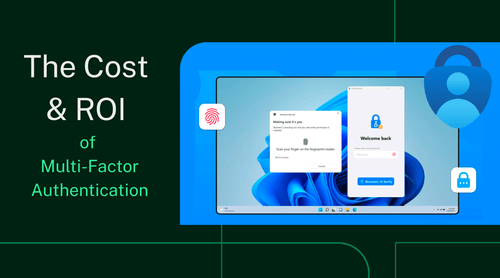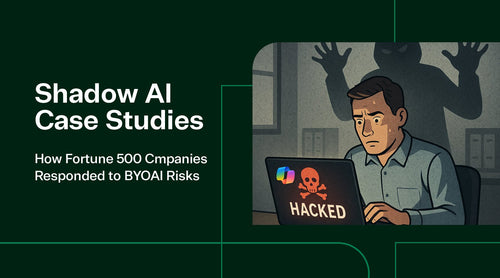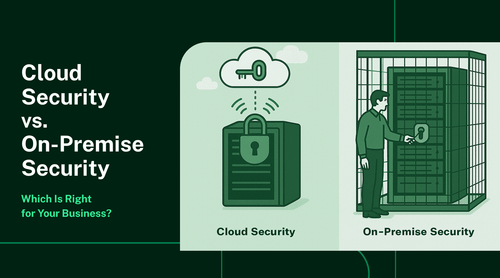In today’s digital landscape, cyberattacks are more frequent, sophisticated, and costly than ever. Yet, many organizations still rely on passwords alone to protect their most sensitive systems and data. Multi-Factor Authentication (MFA) changes that equation; it’s one of the simplest and most effective ways to strengthen security and prevent breaches before they occur. But while MFA is essential, it’s not free; its real costs extend far beyond licensing. Understanding the complete financial picture and long-term ROI can help IT leaders make smarter investments, protect their infrastructure, and build a stronger security posture for the future.
Key Takeaways:
- MFA is a must-have for modern security. It adds an extra layer of protection beyond passwords and is essential for stopping credential-based attacks and meeting compliance standards.
- The actual cost of MFA includes more than licensing. Budget for hardware, rollout, user training, support tickets, and ongoing maintenance (especially at scale).
- The ROI speaks for itself. With the average data breach costing $4.88 million, MFA can deliver significant value by preventing just one serious incident.
- To get the most out of MFA, be strategic. Choose a solution that fits your infrastructure, balance security with user experience, and work with a trusted partner to keep costs down and adoption smooth.
Cybersecurity spending is up. So are data breaches

And while new, shinier security tools continue to hit the market, many companies still overlook one of the simplest and most effective ways to protect their systems: Multi-Factor Authentication (MFA).
MFA is a crucial frontline defense that stops attackers even when passwords get compromised. It protects employee logins, customer data, and access to business-critical systems. It’s also required for many regulatory frameworks, from GDPR to HIPAA.
However, even as a simple yet effective solution, MFA comes with considerable costs, some obvious, others not. And the return isn’t exactly obvious either (in terms of strict numbers), but by preventing costly data breaches (which average $4.88 million globally, according to IBM’s 2024 Cost of a Data Breach report), its value is unmistakable.
To clarify, we have decided to break down the true cost of MFA, where the ROI really lies, and what IT leaders can do to maintain security without creating extra friction.
Why Multi-Factor Authentication is a Business Necessity
With phishing attacks, credential stuffing, and brute-force logins happening constantly, relying on a single password (no matter how strong) is like causing your own undoing. Because once that password is compromised, your entire system is exposed.
That’s where Multi-Factor Authentication (MFA) comes in.
MFA adds an extra layer of security by requiring users to verify their identity in two or more ways, such as a password combined with a mobile notification, a hardware token, or a biometric scan. So, even if one factor (like a password) is stolen, attackers still can’t gain access. Simple but powerful.
And more importantly, it’s no longer optional for enterprises. Many cybersecurity frameworks and regulatory bodies now require MFA to meet compliance standards. This includes (but is not limited to) GDPR, HIPAA, PCI DSS, and ISO/IEC 27001. If your business handles sensitive customer, healthcare, or financial data, you’re expected to have MFA in place.
In short, enforcing MFA is prudent and also a baseline requirement for doing business securely.

Breaking Down the Cost of Multi-Factor Authentication
MFA is simple on paper, but its pricing is not always so transparent. There are two buckets to think about: direct costs and long-term, often-overlooked indirect costs. Let’s break them down.
Direct Costs
Most MFA solutions work on a per-user, per-month basis. You’ll typically pay between $3 and $5 per user per month. Microsoft Entra ID (formerly Azure Active Directory) offers MFA capabilities in different pricing tiers, starting with some basic features included in the free version, and scaling up with Entra ID P1 and P2.
Some setups require physical tokens or biometric devices. That’s a one-time (but not insignificant) upfront cost, plus the administrative hassle and expense of replacing lost or damaged devices.
Additionally, rolling out MFA requires careful planning. You’ll need IT staff hours to configure policies, test integrations, and possibly bring in external experts. That adds to the cost in terms of time, labor, and fees.
Indirect and Long-Term Costs
Lost phones, locked accounts, and sync issues happen. MFA can increase help desk tickets, especially during rollout or when users travel, switch devices, or change numbers.
Moreover, if MFA policies are too rigid, it slows people down. Logging in for everyday tasks shouldn’t feel like a security obstacle course. Without adaptive policies, it can frustrate users and hurt productivity.
Besides, the backend doesn’t manage itself. Someone needs to handle system updates, patch compatibility issues, and stay ahead of changes to authentication protocols. That adds up over time.

Maximizing MFA ROI and Reducing Costs
At the enterprise scale, MFA isn’t cheap. However, compared to a data breach, which can cost companies an average of $4.88 million, as mentioned earlier, it’s a bargain.
In most cases, those breaches start with compromised credentials. That means every phishing or credential theft attack that your MFA blocks is potentially saving you millions, not to mention the downtime, reputational damage, and regulatory fallout that comes with a successful breach.
But to actually see that return, you need to implement MFA correctly:
- Choose the Right Solution - Select an MFA solution that plugs into your existing IT infrastructure. This lets you avoid reinventing your entire stack or adding layers of complexity. For example, if you’re using Microsoft 365, Microsoft Entra ID makes perfect sense, as it can integrate directly with your other Microsoft products.
- Balance Security and Productivity - Security doesn’t have to feel like a chore. Use adaptive or risk-based MFA, where extra authentication only kicks in if something seems suspicious (such as a login from a new location or device). That keeps users moving while still protecting your perimeter.
- Educate Your Users - Even the best MFA system fails without buy-in. Walk your users through what MFA is, why it matters, and how it works. Make it part of the onboarding and ongoing training process, keeping the language clear and non-technical.
- Plan for a Pilot Program - Before implementing MFA company-wide, test it with a small group. This gives you a chance to troubleshoot issues, gather feedback, and refine your rollout plan. It also helps build internal champions who can support wider adoption.
- Go Passwordless - Sounds odd at first, but it’s possible. Solutions like Windows Hello or Microsoft Authenticator let you skip passwords entirely, using biometrics or secure push notifications instead. It’s faster, easier, and actually more secure.

Partnering for a Successful MFA Implementation
Done right, MFA reduces the risk of data breaches, improves login experiences, lowers support costs, and builds long-term resilience into your business. That said, it requires the correct setup, the right licensing, and proper support to deliver the ROI you expect.
That’s where a certified Microsoft Cloud Solution Provider (CSP) can play an invaluable role. They enable businesses of all sizes, SMBs, and mid-sized companies to implement MFA solutions that are secure, scalable, and cost-effective. Make sure they offer the following services:
- Optimize Licensing: We’ll guide you through Microsoft Entra ID licensing, helping you choose the right tier and avoid paying for unnecessary features.
- Provide Hands-On Support: From pilot planning to full rollout, our U.S.-based experts are here to help. We handle migration, policy configuration, and troubleshooting to ensure a smooth and successful rollout.
- Offer Expert Guidance: Need to balance security with user experience? Looking to go passwordless? We help you evaluate your options and build an MFA strategy that actually fits your business, not just your tech stack.
When you work with TrustedTech, you get more than just a product; you get a partner. One who understands Microsoft licensing inside out, cares about usability and risk, and stays in your corner long after MFA deployment. Get in touch to make your MFA rollout secure, seamless, and worth every penny.
FAQ: The Cost & ROI of Multi-Factor Authentication (MFA)
Q: What is Multi-Factor Authentication (MFA) and why is it important?
A: MFA is a security measure that requires users to verify their identity in two or more ways (e.g., password plus mobile notification, hardware token, or biometric scan). It’s essential because it adds a strong layer of protection beyond passwords, stopping attackers even if a password is compromised. MFA is also required by many compliance standards (GDPR, HIPAA, PCI DSS, ISO/IEC 27001).
Q: What are the main costs associated with implementing MFA?
A: MFA costs include:
- Direct costs: Licensing fees (typically $3–$5 per user/month), hardware tokens or biometric devices, and IT staff time for setup and integration.
- Indirect/long-term costs: Increased help desk tickets (e.g., lost phones, locked accounts), potential productivity slowdowns if policies are too rigid, and ongoing maintenance (system updates, compatibility, protocol changes).
Q: How does MFA provide a return on investment (ROI)?
A: The ROI of MFA is significant because it helps prevent data breaches, which cost organizations an average of $4.88 million per incident. By blocking credential-based attacks, MFA can save millions, avoid downtime, and prevent reputational damage and regulatory penalties.
Q. How can organizations maximize the ROI and reduce the costs of MFA?
- Choose the right solution: Integrate MFA with your existing IT infrastructure to avoid unnecessary complexity.
- Balance security and productivity: Use adaptive/risk-based MFA to minimize user friction.
- Educate users: Provide clear, non-technical training and ongoing support.
- Pilot before full rollout: Test with a small group to troubleshoot and refine the process.
- Consider passwordless options: Solutions like Windows Hello or Microsoft Authenticator can improve security and user experience.
Q: What are common challenges when rolling out MFA?
- User resistance or confusion
- Increased support tickets during rollout
- Potential productivity impacts if MFA is too rigid
- Managing lost devices or account lockouts
Q: How can a partner like TrustedTech help with MFA implementation?
A: TrustedTech offers: Licensing optimization (choosing the right Microsoft Entra ID tier) Hands-on support (from pilot to full rollout) Expert guidance (balancing security and usability, exploring passwordless options) Ongoing support and troubleshooting














